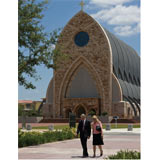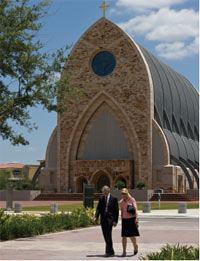
A Cut Above
New Florida university among world’s most technologically-advanced schools
- By Megan Weadock
- Oct 30, 2008
 Every university security official must dream of a
fully converged solution that ties together as
many campus functions as possible: surveillance,
access control, HVAC, fire and IT.
Every university security official must dream of a
fully converged solution that ties together as
many campus functions as possible: surveillance,
access control, HVAC, fire and IT.
That dream recently came true for Bryan Mehaffey,
vice president of technology and system engineering at
Ave Maria University. The school is the first new
Catholic university built in the United States in more
than 40 years—and it’s among the world’s most technologically advanced campuses.
A Unique University
Ave Maria University, located in southwest Florida,
opened its doors on Aug. 27, 2007. The university
is the product of founder and chancellor Thomas S.
Monaghan’s dream to build an institution of higher education
faithful to the teachings of the Catholic Church.
After more than five years of planning and construction,
and four years of operating from a temporary campus
in Naples, the university made its permanent home
on a 908-acre campus in a new town named just for it:
Ave Maria. The campus has 500,000 square feet of facilities,
with plenty of growing room. It serves nearly 500
students and 200 faculty and staff.
Monaghan recognized the need to put technology
first for today’s students.
“Kids today are looking for high-tech solutions,” he
said. Safety is a huge factor as well, especially considering
the fact that Ave Maria sees more than 1,000 visitors
a day. “In the wake of some of the tragedies that have
happened around the world, moms and dads want to
know their kids are safe.”
Once ground broke for the new university, there
were only 20 months left for construction in order for
classes to begin on time. Another challenge arose when
Mehaffey decided to incorporate IT operations and
facility operations into one group, and to combine the
university’s IT infrastructure, fire, security, HVAC and
building control systems on a common platform.
After considering proposals from Honeywell and
Siemens, officials chose Johnson Controls as Ave
Maria’s technology partner. The school successfully converged
23 systems on a single IP network.
“We learned quickly that this was an approach most
architects and engineers were not accustomed to,”
Mehaffey said. “But it was obvious Johnson Controls
understood our vision and knew exactly what we wanted
to do.”
Convergence at its Best
At Ave Maria, Johnson Controls oversaw the design
and installation of an IP backbone, as well as all the
technology that resides on the network. LonMark, an
open data protocol, allowed equipment from multiple
vendors to be installed and integrated on the same
infrastructure. As a result, unnecessary networks and
cabling were avoided. This innovation also makes Ave
Maria’s campus future ready.
The systems in use include Johnson Controls
Metasys® building management and P2000 security
management systems, Cisco data equipment, Notifier
fire panels, GE lighting, IClass smart cards, HID proximity
readers, HVAC components, a Maximo maintenance
management system, an AVI A/V distribution system
and servers.
According to Johnson Controls, Ave Maria saved
approximately $1.5 million by avoiding unnecessary and
redundant cabling included in the first campus design.
The university also will save hundreds of thousands of
dollars a year from reduced utility costs.
“Picking one contractor to do this project saved an
enormous amount of not only money, but something
more costly—time,” Mehaffey said. “That’s because we
were able to reach out to one partner, consolidate all of
the project management, mobilization and overhead
costs into one platform.
“We manage the entire campus operations with just
seven full-time employees, which is pretty lean when
you consider the alternative of as many as 24 people.”
All of the systems on campus are managed from the
network operations center. Operators use the Metasys
system to monitor, control and largely automate the
campus’s chiller plant, heating and cooling, indoor air
quality, laboratory air flow, lighting and lavatories. The
system also is responsible for power management and
asset tracking. Other systems monitored from the center
include Internet, e-mail, fire panels, digital video
monitoring, and security and access control via the
Johnson Controls P2000 system. And, because all the
systems are Web enabled, operators can monitor and
control them from their smart phones.
Ave Maria officials also implemented a One Card
system, which gives students, faculty and staff individually
tailored access to dormitories and academic buildings,
including labs and computer rooms. It also acts as
a library and debit card for the cafeteria, the bookstore,
copying and printing.
Ready for Anything
The converged systems’ open architecture will make
expansion easy as Ave Maria grows over the years.
Officials expect the university to include more than
5,500 students one day. According to Mahaffey, that will
be no problem.
“I feel the university is as future-ready as it could
possibly be because of what we’ve accomplished with
Johnson Controls’ help,” Mahaffey said.
This article originally appeared in the issue of .